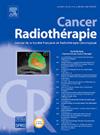保留海马全脑放疗先进放疗计划技术的剂量学比较
IF 1.4
4区 医学
Q4 ONCOLOGY
引用次数: 0
摘要
目的保留海马的全脑放射治疗旨在减轻颅脑放射治疗患者的神经认知能力下降。放射治疗计划系统的进步提供了在保持靶覆盖的同时更好地保留处于危险中的器官。本研究比较了保留海马全脑放疗的五种计划技术的剂量学性能:放射场宽度为1厘米和2.5厘米的Radixact、Ethos、HyperArc和使用先进优化算法的体积调制放射治疗。材料与方法回顾性计划研究包括6例全脑辐照患者。处方剂量为30 Gy,分12组,海马剂量约束d98%≤9 Gy, D2 %≤17 Gy。使用VOLO™Ultra优化器创建Radixact计划,并使用正常组织物镜参数进行剂量下降控制。Ethos计划是使用具有自动规划的智能优化引擎生成的。HyperArc采用4条非共面弧线,SRS正常组织目标优化,而体积调制弧线治疗采用6条弧线。剂量学参数,包括计划靶体积覆盖、海马剂量和有风险限制的器官,采用单因素方差分析进行分析。结果视场宽度为1cm的放射治疗可获得最低的海马剂量,而HyperArc和体积调节放射治疗可提供更好的计划靶体积覆盖。Ethos对危险器官的剂量最低,而HyperArc的治疗时间最短。统计学差异显著(P <;0.05),海马d98%, D2 %,并保留危险器官。结论先进的计划技术在保留海马的全脑放疗中具有明显的剂量学优势。视野宽度为1厘米的根治法能最佳地保护海马,而HyperArc和体积调节根治法能以更短的治疗时间平衡对危险器官的保护。选择最佳计划方法应考虑剂量学结果和临床工作流程效率。本文章由计算机程序翻译,如有差异,请以英文原文为准。
Dosimetric comparison of advanced radiotherapy planning techniques for hippocampal sparing whole brain radiotherapy
Purpose
Hippocampal-sparing whole-brain radiotherapy aims to reduce neurocognitive decline in patients receiving cranial irradiation. Advances in radiotherapy planning systems offer improved sparing of organs at risk while maintaining target coverage. This study compared the dosimetric performance of five planning techniques for hippocampal-sparing whole-brain radiotherapy: Radixact with 1 cm and 2.5 cm field widths, Ethos, HyperArc, and volumetric modulated arctherapy using advanced optimization algorithms.
Materials and methods
Eleven patients who underwent whole brain irradiation were included in this retrospective planning study. The prescribed dose was 30 Gy in 12 fractions, with hippocampus dose constraints of D98 % ≤ 9 Gy and D2 % ≤ 17 Gy. Radixact plans were created using the VOLO™ Ultra optimizer with normal tissue objective parameters for dose fall-off control. Ethos plans were generated using an intelligent optimization engine with automated planning. HyperArc employed four non-coplanar arcs with SRS normal tissue objective optimization, while volumetric modulated arctherapy utilized six arcs. Dosimetric parameters, including planning target volume coverage, hippocampal doses, and organs at risk constraints, were analyzed using one-way ANOVA.
Results
Radixact with 1 cm field width achieved the lowest hippocampal doses, whereas HyperArc and volumetric modulated arctherapy provided superior planning target volume coverage. Ethos resulted in the lowest doses to organs at risk, while HyperArc had the shortest treatment duration. Statistically significant differences (P < 0.05) were observed across techniques for hippocampal D98 %, D2 %, and sparing of organs at risk.
Conclusion
Advanced planning techniques offer distinct dosimetric advantages for hippocampal-sparing whole-brain radiotherapy. Radixact with 1 cm field width optimally spares the hippocampus, while HyperArc and volumetric modulated arctherapy balance sparing of organs at risk with shorter treatment times. Selection of an optimal planning approach should consider both dosimetric outcomes and clinical workflow efficiency.
求助全文
通过发布文献求助,成功后即可免费获取论文全文。
去求助
来源期刊

Cancer Radiotherapie
医学-核医学
CiteScore
2.20
自引率
23.10%
发文量
129
审稿时长
63 days
期刊介绍:
Cancer/radiothérapie se veut d''abord et avant tout un organe francophone de publication des travaux de recherche en radiothérapie. La revue a pour objectif de diffuser les informations majeures sur les travaux de recherche en cancérologie et tout ce qui touche de près ou de loin au traitement du cancer par les radiations : technologie, radiophysique, radiobiologie et radiothérapie clinique.
 求助内容:
求助内容: 应助结果提醒方式:
应助结果提醒方式:


